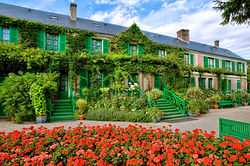Fondation Monet in Giverny
| Fondation Claude Monet | |
|---|---|
|
Claude Monet's house from the garden | |
 Location within France | |
| Established | 1980 |
| Location | Giverny, France |
| Coordinates | 49°04′31″N 1°32′02″E / 49.0753559°N 1.5337515°E |
| Visitors | 530,000 (2010) |
| Website |
fondation-monet |
The Fondation Claude Monet is a nonprofit organisation that runs and preserves the house and gardens of Claude Monet in Giverny, France. With a total of 530,000 visitors in 2010, it is the second most visited tourist site in Normandy after the Mont-Saint-Michel.[1] The House and Garden have been recognised as a "Maison des Illustres"[2] and "Jardin remarquable" rewarding their outstanding qualities. The estate was classified as a Monument historique in 1976.
History
Claude Monet lived in Giverny from 1883 to his death in 1926, and directed the renovation of the house, retaining its pink-painted walls. Colours from the painter's own palette were used for the interior -green for the doors and shutters, yellow in the dining room, complete with Japanese Prints from the 18th and 19th centuries, and blue for the kitchen. Monet had the nearby river Epte partially diverted for the gardens and hired up to seven gardeners to tend to it.
When Monet died in 1926, the entire estate was passed on to his son Michel. As he never spent time in Giverny, it was left to Blanche Monet-Hoschedé, the daughter of Alice and the widow of Jean Monet, to look after the garden with the help of former head gardener Louis Lebret. After Blanche died in 1947, the garden was left untended.
Michel Monet died heirless in a car crash in 1966. He had bequeathed the estate to the Académie des beaux-arts. From 1977 onwards, Gérald Van der Kemp, then curator at the Château de Versailles played a key role in the restoration of the neglected house and gardens, which had been left in a desolate state. In a bid to raise funds, he and his wife Florence appealed to American donors through the "Versailles Foundation-Giverny Inc.".[3] They, thereafter, dedicated themselves to its restoration.
The Fondation Claude Monet was created in 1980 as the estate was declared public. It soon became very successful now welcomes both French and international visitors from April to November.
When Gérald Van der Kemp died in 2001, Florence Van der Kemp became the curator of the Fondation Monet and continued renovating the property until her death in 2008.
Hugues Gall was appointed Director of the Fondation Claude Monet by the Académie des beaux-arts in March 2008.
The House
Visitors have access to:
- The ground floor: the blue salon (the reading room), the "épicerie" (the larder), the living room/studio, the dining room and the blue-tiled kitchen.
- The first floor: the family rooms, including Monet's which was renovated in March 2013 as well as Alice Hoschedé's bedroom and their private apartments. Also visible now is the room of Blanche Hoschedé, which was recreated in 2013 based on archives and existing elements present in the house.
The Gardens
The Gardens are divided into two distinctive parts, which have been restored according to Monet's own specifications:
- The Clos-Normand was modelled after Monet's own artistic vision when he settled in Giverny. He spent years transforming the garden into a living en plein air painting, planting thousands of flowers in straight-lined patterns.
- Across the road from the Clos-Normand, Monet acquired in 1893 a vacant piece of land across the road, which he transformed into a water garden by diverting water from the stream Ru, an arm of the Epte river. That garden became famous during his lifetime with his series of monumental paintings, the Nymphéas. The water garden is marked by Monet's fascination for Japan, with its green Japanese bridge and oriental plants. The waterlilies were meticulously tended by a gardener employed for that sole purpose.
The Japanese Prints Collection
The majority of Monet's paintings are kept in the Musée Marmottan Monet. However, Monet's house is home to a collection of more than 200 Japanese ukiyo-e prints from the 18th and 19th centuries. Among the most notable pieces are works by Kitagawa Utamaro (1753–1806), Katsushika Hokusai (1760–1849) and Utagawa Hiroshige (1797–1858).
References
- ↑ Secrets d'histoire, « Claude Monet: jardins secrets à Giverny », Broadcast on France 2, 30 August 2011
- ↑ Ministère de la Culture
- ↑ "The Versailles Foundation & Giverny". Theversaillesfoundationinc.com. Retrieved 2013-12-24.
Bibliography
- Claire Joyes, Claude Monet à Giverny, la visite et la mémoire des lieux, Éditions Claude Monet/Gourcuff/Gradenigo, 2010,
ISBN 978-2-35340-076-8
- Hélène Rochette, Maisons d'écrivains et d'artistes. Paris et ses alentours, pp. 224–229, Parigramme, Paris, 2004, ISBN 2-84096-227-6
